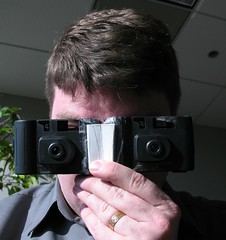The problem boils down to taking two photos side by side, usually done by snapping one photo, and then moving the camera laterally a few inches and taking another. Lay the photos side by side, cross your eyes, and you should be able to see the result in 3-D. The modern solution now seems to be to strap or otherwise connect two inexpensive digital cameras side by side and take the photos, sometimes even with a custom rig to press the shutter release at the same time. This last aspect is actually key: if you're trying to take a 3-D picture of something in motion, the lapse between side-to-side photos is enough to make a "shiny" spot on the combined image as your brain tries to resolve the conflicting images from each eye. Better to take a still subject on an evenly-lit day. My grandfather fashioned a simple platform for his tripod that he could use like a portable table, but lugging a tripod around is not exactly practical for a casual experiment.
 I'd like to use my grandfather's viewer, though, if only because the eye-crossing thing makes my head hurt after a while. And I am, as you know, incredibly, incredibly cheap, far too cheap to actually buy two digital cameras from Walgreen's and Velcro them together. So here's my first experiment: the $2 stereo. Two disposable cameras from the dollar store, held together with tape and cardboard scavenged from the supply room. The distance between the lenses is slightly wide, but this will supposedly result in something called "hyper stereography" which results in a slightly exaggerated effect. For two dollars it's not worth fussing about. More worrisome is the large gap around the case of on of the cameras, which may let in light. I may wind up with a roll of lots of tree photos, and a roll of sunlight.
I'd like to use my grandfather's viewer, though, if only because the eye-crossing thing makes my head hurt after a while. And I am, as you know, incredibly, incredibly cheap, far too cheap to actually buy two digital cameras from Walgreen's and Velcro them together. So here's my first experiment: the $2 stereo. Two disposable cameras from the dollar store, held together with tape and cardboard scavenged from the supply room. The distance between the lenses is slightly wide, but this will supposedly result in something called "hyper stereography" which results in a slightly exaggerated effect. For two dollars it's not worth fussing about. More worrisome is the large gap around the case of on of the cameras, which may let in light. I may wind up with a roll of lots of tree photos, and a roll of sunlight.Simultaneous shutter release will be attempted by a clever mechanism known as "I have two hands, don't I?" I'm going to head out at lunch today and see what develops.
Post-lunch update: not surprisingly, one of the cameras crapped out after a couple of shots, but I dropped off the film anyway. If it works at all, I'll be inclined to try again with something more durable.

1 comment:
Good luck with that. I'm all for cheapo DIY photography.
Somewhere, I have a 1950-ish photography magazine that gives directions on how to build your own stereo camera from a pair of 127 Brownies. That's one of about a thousand things I mean to scan one of these days.
Depending upon where the shutter releases are located, you could probably glue a pair of pencil erasers to a popsicle stick as use that as the trigger for simultaneous exposures.
Post a Comment